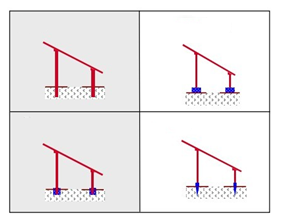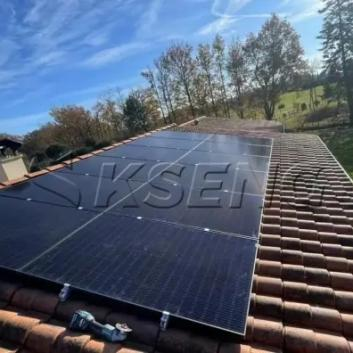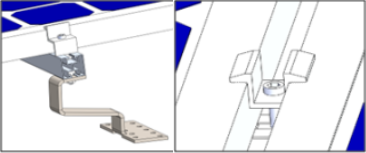PV mounting system has a variety of classification methods, such as welding type and assembly type according to the connection method, fixed type and daily type according to the installation structure, and ground type and roof type according to the installation location. No matter what kind of photovoltaic system, the structure of its bracket is generally similar, including connectors, columns, keels, beams, auxiliary parts and other parts.
Fixed roof PV mounting system
Fixed roof PV mounting system, as the name suggests, refers to a mounting system that keeps its orientation and angle unchanged after installation. The fixed installation method directly places the solar photovoltaic modules towards the low-latitude area (at a certain angle to the ground), and forms a solar photovoltaic array in a series-parallel manner, so as to achieve the purpose of solar photovoltaic power generation. There are many kinds of fixing methods, such as the pile foundation method (direct embedment method), concrete block counterweight method, pre-embedded method, ground anchor method, etc., and the roof fixing method has different schemes depending on the roofing material. .

For different roofing materials, there will be different photovoltaic support systems:
1)Glazed tile roof PV mounting system
As shown in Figure 1, glazed tiles are construction materials made of soft and hard materials such as alkaline earth and purple sand after extrusion, plastic pressing, and firing. The material is brittle and has poor load-bearing capacity.

Picture 1
When installing the bracket, a specially designed main support member is usually fixed to the lower roof of the glazed tile to support the main beam and beam of the bracket. The support members such as the connecting plate are usually designed with multiple openings as shown in Figure 2, which is flexible and effective. Bracket position adjustment. Aluminum alloy pressing blocks are used for crimping between components and beams.

Picture 2
2)Metal roof mounting system
Metal plate is a steel formed by cold pressing or cold rolling of thin steel plate. The steel plate adopts organic coated thin steel plate (or color steel plate), galvanized thin steel plate, anti-corrosion thin steel plate (asbestos-containing asphalt layer) or other thin steel plates.
Profiled steel plate has the advantages of light unit weight, high strength, good seismic performance, fast construction, beautiful appearance, etc. It is a good building material and component, mainly used for enclosure structures, floors, and other structures.
Metal roof are generally divided into: upright seam type, bite type (corner type) type, buckle type (concealed type) type, and fastener connection (nail type) type.

Picture 3
When installing a photovoltaic system on a metal roof, the shape and load-bearing capacity of the metal roof should be fully considered to determine the fixing method of the bracket. The fixing method of the matel roof bracket is mainly determined according to the shape of the color steel tile, as shown in Figure 4:

Picture4
3)
Concrete Roof PV mounting system
Concrete roof PV mounting systems are generally fixed with a fixed inclination angle, and can also be arranged in a tiled manner. This type of roof fixing method is mainly fixed by concrete foundation and standardized fixed connectors, which are divided into two ways: cast-in-place type and pre-cast type.

Picture 5
The cast-in-place rectangular foundation on the concrete roof is suitable for roofs in areas with small bearing capacity and high wind load; as shown in the figure below: 1 The rectangular foundation is connected to the roof with chemical anchor bolts; 2 Standardized fixed connectors are installed on the rectangular foundation; 3. Brackets Assembled with components.
A precast rectangular foundation is placed on the concrete roof, which is suitable for roofs in areas with small bearing capacity and small wind load; standardized fixed connectors are prefabricated on the rectangular foundation.

Picture 6






